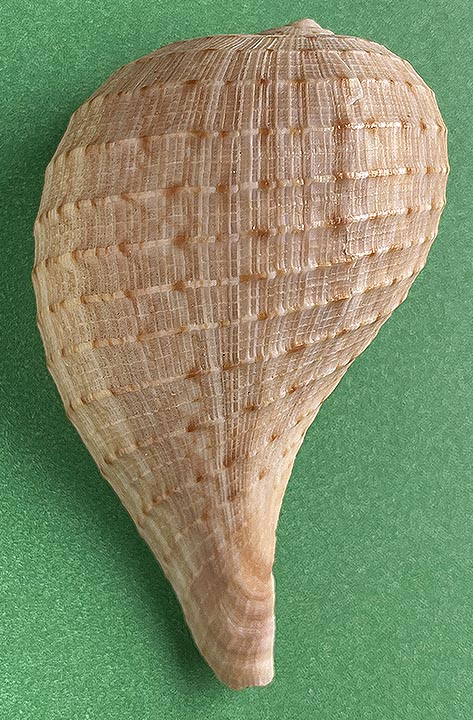The Latin word "ficus" means "fig." This name distinguishes the gastropod seashell Ficus without hestitation. Its thin shell has a large inflated body whorl and a short spire. The aperture is very long and wide, with a thin outer lip. There is no operculum (“trap door”). The shells of Ficus have a latticed surface consisting of very narrow spiral ribs. Although the overall shape ("fig" or "pear" shape) and sculpture are distinctive, the shells of individual species can closely resemble one another, and it takes a discerning eye to distinguish them. Shell color is yellowish to brown, with a series of darker dots, bands, and/or blotches. The size range of the Ficus shell is about 50 mm to about 160 mm in length. The naming history of Ficus is complex, with many no longer used synonyms.
Front and back views of a specimen of Ficus ventricosa (G.B. Sowerby, I, 2825), height 3 inches, width 1 3/4 inches, from Pacific Panama.Members of the family Ficidae have been, and still are, warm-water dwellers. They first appeared during the late Cretaceous (Maastrichtian time), but genus Ficus did not evolve until the early Eocene (Squires, 2014, fig. 3). Ficus today occurs principally in the Indo-West Pacific, Caribbean, and Panamic provinces (Verhaeghe and Poppe, 2000).
For an exhaustive list of the geographic distribution of fossil species (including those with a Holocene = recent record), see Squires (2014, table 3).
Ficus lives today in shallow to deep sand and coral-rubble: most often at a depth of 10 to 20 m although there are a few species that can live at depths as much as 300 m.
The family Ficidae is closely related to some tonnid gastropods, and more research is needed to fully understand this relationship.
Referenes Cited:
Eichhorst, T. 2001. Family Ficidae. American Conchologist 29(1):24-25.
Squires, R.L. 2014. Fossil record of the ficid gastropods Urosyca, Priscoficus, and Ficus from coastal-western North America: phylogenetic and global paleobiogeographic implications. Contributions in Science 522:1–27.
Verhaeghe, M. and G.T. Poppe. 2000. The Family Ficidae. A conchological iconography. ConchBooks, 30 pp.


No comments:
Post a Comment